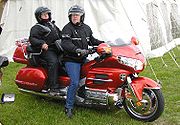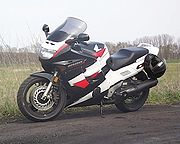Various features and accessories may be attached to a motorcycle either as OEM (factory-fitted) or after-market.

- Fairing
The most prominent of the plastic or fibreglass shells covering parts of the motorcycle is the "fairing". In practice, this may blend almost seamlessly with engine panels or wheel covers/mudguards (which in some cases will be painted or plated metal). These systems act to protect the rider from some or all of the weather, may improve aerodynamics (reducing drag), and are an important styling element. Full enclosure, the dustbin fairing, went out of fashion, partly for safety reasons - they were banned in racing in 1958 by the FIM.
Modern fairings, mostly designed specifically for each motorcycle and fitted as original equipment by the manufacturer, have eliminated the aerodynamic and structural failings of early add-on fairings. Both sports and tourer versions improve (sometimes very considerably) the rider's comfort in cold and wet weather and even "bikini" versions protect the vulnerable crotch region from water ingress.
- Windscreen
Also called windshields or screens, windscreens can be built into a fairing or be attached to an otherwise unfaired bike. They are usually made from transparent high-impact acrylic plastic. They may be shaped specifically to direct air flow over or around the head of the rider even if they are much shorter than the seated rider. The latest variation, introduced on the 1986 BMW K100LT, is electrically controlled height adjustment.
- Saddlebags or panniers
Saddlebags or panniers mount on either side of the rear of the motorcycle roughly beside (but not interfering with) the pillion passenger. "Hard" panniers commonly come in an injection moulded plastic such as ABS, and "soft" panniers come in some form of textile (eg Cordura) or leather. Panniers are nearly always detachable and often lockable, both of their mountings and their closure. Side-loading panniers are especially suitable for carefully packed clothing and taking into hotel rooms (like a suitcase), while top-loading hard panniers are preferred by other users. Utility top-loading soft panniers often come in a "throw-over" form without mountings or fixings, perhaps safely held in place under the rider or pillion - or simply loose.
Modern touring motorcycles often have panniers fitted as standard or they may be available as options on particular models. But most panniers come from local workshop industries which are not formally linked to the manufacturers of the motorcycle. The fixings of such panniers will be model specific, but the lucky rider may have a choice as to the actual case carried.
- Heated hand grips/seats
Since motorcycles lack climate control or proper protection from the wind, some manufacturers offer heated seats or hand grips to relieve the discomfort of low temperatures experienced during night riding or the colder months. They can also be added on as after-market accessories and are powered by the bike's electrical system.
- Luggage rack
A common addition to many bikes is an attachment onto which bags or other luggage can be fastened. This removes the need for rider backpacks and is generally a more secure and a safer way to add carrying capacity to a motorcycle. In the 1950s the popular British motorcycle Triumph often came with a tank-mounted carrier. Load-security was better, but they lost popularity over the unproven, but keenly felt, danger to the rider in the event of a front-end collision.
- Sidecar
A sidecar turns a motorcycle into a three-wheeled vehicle. Their peak popularity (160,000 in the UK in 1955[16], pre-WWII in the US) came about when powerful motorcycles were available, but there were relatively few cars about. Sidecars such as the British Watsonian were coach-built in wood and had doors, sliding windows and even a sun-roof, but modern sidecars may be fibreglass or aluminium. Alignment of the sidecar is critical and the mountings come under considerable stress, making a quickly-detachable version largely impractical - in any case, the special sidecar tyres are poorly-suited to solo riding.
The cornering of "an outfit" is partly controlled by the throttle and this makes for interesting effects - a sidecar wheel brake fitted (usually a pedal side-by-side with the motorcycle rear brake) helps considerably. Sidecars place a heavy strain on wheel bearings, wheel-spokes and suspension components - even frames and engines may suffer. A hinged sidecar known as the "Sidewinder" became available in the UK in the 1970s, but its popularity came about due to driver licensing requirements, its carrying capacity being approximately limited to one tool-box.
- Trailer hitch
A trailer hitch or tow hitch is a device mounted on a motorcycle that enables it to tow a motorcycle trailer. Legislation will often restrict them to carrying baggage but not passengers.
- Trunk
Storage compartments are largely restricted to scooters, they may be underneath the seat, between the knees or in front of the steering head. A motorcycle trunk will normally be mounted behind the seat where it is known as a top box.
- Crash bar
Crash bars are less popular than they used to be - vulnerable engines and fairings now sometimes being protected by OE fitted snubs instead. A common arrangement is a loop of chrome-plated steel tube mounted each side of a motorcycle's lower frame. They primarily protect the bike's engine and body panels during slides or tipovers but can also serve as a mount point for accessories like highway pegs, lights and, on police motorcycles, sirens, cameras and radar guns. They give little protection to the rider and bigger ones were sometimes linked to injuries when feet became trapped. Less common variations include sump-guards, primarily for off-road riding.





No comments:
Post a Comment